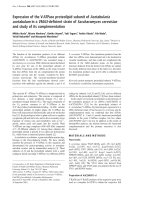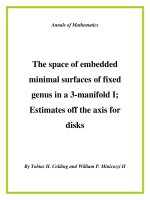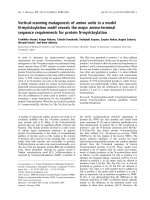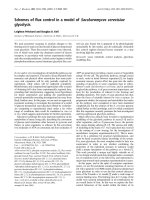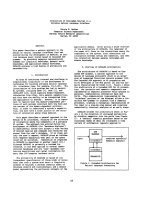Self localization of humanoid robot in a soccer field
Bạn đang xem bản rút gọn của tài liệu. Xem và tải ngay bản đầy đủ của tài liệu tại đây (811.27 KB, 76 trang )
SELF-LOCALIZATION OF HUMANOID ROBOT
IN A SOCCER FIELD
TIAN BO
A THESIS SUBMITTED
FOR THE DEGREE OF MASTER OF ENGINEERING
DEPARTMENT OF MECHANICAL ENGINEERING
NATIONAL UNIVERSITY OF SINGAPORE
2010
ACKNOWLEDGMENTS
I would like to express my appreciation to the my supervisor, Prof. Chew Chee Meng, for
the opportunity to work on the RoboCup project and the chance to gain valuable
experience from the prestigious RoboCup competitions, as well as for his patient
guidance in the various aspects of the project.
Next, the author wishes to thank the following people for their assistance during the
course of this project:
1) The members of Team ROPE, Samuel, Chongyou, Chuen Leong, Xiyang,
Ruizhong, Renjun, Junwen, Bingquan, Wenhao, Yuanwei, Jiayi, Jia Cheng, Soo
Theng, Reyhan, Jason and all the other team members, for their friendship and
untiring efforts towards the team’s cause. Their dedication and unwavering spirit
was motivating and inspiring.
2) Mr. Tomasz Marek Lubecki for his insights and suggestions with regards to many
aspects of the project.
3) Mr. Huang Wei-wei, Mr Fu Yong and Mr Zheng Yu, for their guidance and
suggestions on advanced algorithms applied on the robots.
4) The professors, technicians, staff and students in the Control and Mechatronics
Laboratories 1 and 2, for their unwavering technical support and advice.
Last, I want to thank my parents. This thesis is dedicated to them.
i
TABLE OF CONTENTS
Chapter
Page
I. INTRODUCTION ......................................................................................................1
1.1 Motivation ..........................................................................................................1
1.2 Localization........................................................................................................2
1.3 Particle Filter ......................................................................................................3
1.4 RoboCup and Robot System ..............................................................................4
1.4.1 RoboCup ...................................................................................................4
1.4.2 Hardware ...................................................................................................5
1.4.3 Vision ........................................................................................................6
1.4.4 Locomotion ...............................................................................................6
1.4.5 Field ..........................................................................................................7
1.5 Contributions of the Work .................................................................................7
1.5.1 Problems ...................................................................................................7
1.5.2 Contributions.............................................................................................8
1.6 Thesis Outline ....................................................................................................9
II. LITERATURE REVIEW........................................................................................10
2.1 Localization......................................................................................................10
2.2 Localization in RoboCup .................................................................................11
2.3 Particle filter.....................................................................................................13
2.3.1 Motion Model .........................................................................................13
2.3.2 Vision Model ..........................................................................................14
2.3.3 Resampling .............................................................................................16
III. PARTICLE FILTER LOCALIZATION ...............................................................17
3.1 Software Architecture of RO-PE VI System ...................................................17
3.2 The Kinematic Configuration for Localization................................................18
3.3 Particle Filter Algorithm ..................................................................................19
3.4 Motion Model ..................................................................................................22
3.4.1 Kinematic Motion Model ........................................................................22
3.4.2 Noise Motion Model ...............................................................................24
ii
Chapter
Page
3.5 Vision Model ...................................................................................................25
3.5.1 The Projection Model of Fisheye Lens ...................................................25
3.5.2 Robot Perception .....................................................................................26
3.5.3 Update .....................................................................................................29
IV. SIMULATION ......................................................................................................31
4.1 The Simulation Algorithm ...............................................................................31
4.1.1 The Particle Reset Algorithm..................................................................32
4.1.2 The Switching Particle Filter Algorithm.................................................33
4.1.3 Calculation of the Robot Pose.................................................................35
4.2 Simulation Result of the Conventional Particle Filter
with Particle Reset Algorithm................................................................................36
4.2.1 Global Localization .................................................................................36
4.2.2 Position Tracking ....................................................................................38
4.2.3 Kidnapped Problem ................................................................................40
4.3 The Simulation of the Switching Particle Filter Algorithm .............................43
4.4 Conclusion .......................................................................................................45
V. IMPLEMENTATIONS ..........................................................................................46
5.1 Introduction ......................................................................................................46
5.2 Experiment for Motion Model and Vision Model ...........................................47
5.2.1 Experiment for Motion Model ................................................................48
5.2.2 Experiment for Vision Model .................................................................49
5.3 Localization Experiment and the Evaluation ...................................................51
5.3.1 Improvement on Transplanting the Program to an Onboard PC 104 .....52
5.3.2 Evaluation of the Particle Filter Localization Algorithm Onboard ........54
5.4 Future Work .....................................................................................................55
VI. CONCLUSION.....................................................................................................56
REFERENCES ............................................................................................................58
APPENDICES .............................................................................................................60
iii
SUMMARY
RoboCup is an annual international robotics competition that encourages the research and
development of artificial intelligence and robotics. This thesis presents the algorithm
developed for self-localization of small-size humanoid robots, RO-PE (RObot for
Personal Entertainment) series, which participate in RoboCup Soccer Humanoid League
(Kid-Size).
Localization is the most fundamental problem to providing a mobile robot with
autonomous capabilities. The problem of robot localization has been studied by many
researchers in the past decades. In recent years, many researchers adopt the particle filter
algorithm for localization problem.
In this thesis, we implement the particle filter on our humanoid robot to achieve selflocalization. The algorithm is optimized for our system. We use robot kinematic to
develop the motion model.
The vision model is also built based on the physical
characteristics of the onboard camera. We simulate the particle filter algorithm in
MatLab™ to validate the effectiveness of the algorithm and develop a new switching
particle filter algorithm to perform the localization. To further illustrate the effectiveness
of the algorithm, we implement the algorithm on our robot to realize self-positioning
capability.
iv
LIST OF TABLES
Table
Page
5-1: Pole position in the image, according to different angles and distances ...........50
5-2 Relationship between the pole distance and the width of the pole in image ......51
v
LIST OF FIGURES
Figure
Page
1-1: A snapshot of RO-PE VI in RoboCup2008 ...............................................................5
1-2: RO-PE VI Camera Mounting ..................................................................................6
1-3: RoboCup 2009 competition field (to scale) ...............................................................7
2-1: RO-PE VI vision system using OpenCV with a normal wide angle lens ...................15
3-1: Flowchart of RO-PE VI program and the localization part ......................................18
3-2: The layout of the field and the coordinate system, the description of the particles .....19
3-3: Particle Filter Algorithm .......................................................................................20
3-4: Resampling algorithm ‘select with replacement’ .....................................................22
3-5: Flowchart of the motion and strategy program .......................................................23
3-6: Projection model of different lens .........................................................................26
3-7: The projective model of the landmarks ..................................................................27
3-8: Derivation of the distance from the robot to the landmark .......................................29
4-1: The switching particle filter algorithm ...................................................................34
4-2: Selected simulation result for global localization with different number of particles .37
4-3: Selected simulation result for position tracking with different number of particles ....39
4-4: The simulation result for odometry result without resampling .................................41
4-5: Selected simulation result for kidnapped localization with different number of particles
......................................................................................................................................42
4-6: Grid-based localization with position tracking .......................................................44
vi
Figure
Page
5-1: Brief flowchart of the robot soccer strategy ...........................................................46
5-2: The odometry value and the actual x displacement measurement..............................48
5-3: Part of the images collected for the experiment for vision model ..............................49
5-4: Modified structure for particle filter algorithm .......................................................52
5-5: The simplified ‘select with replacement’ resampling algorithm ...............................53
5-6: The image captured by the robot when walking around the field .............................54
5-7: The localization result corresponding to the captured image ...................................54
A-1: The kinematic model for the robot’s leg ...............................................................60
A-2: Side plane view for showing the hip pitch and knee pitch .......................................61
A-3: Front plane view for showing the hip roll .............................................................61
A-4: Coordinate transformation when there is a hip yaw motion ....................................62
A-5: Schematic diagram for odometry ..........................................................................63
B-1: Derivation of the angle between the robot and the landmark ...................................64
vii
CHAPTER I
INTRODUCTION
This thesis presents the algorithm developed for self-localization of small-size humanoid
robots, RO-PE (RObot for Personal Entertainment) series, which participate in RoboCup
Soccer Humanoid League (Kid-Size). In particular, we focus on the implementation of
the particle filter localization algorithm for the robot RO-PE VI. We developed the
motion model and vision model for the robot, and also improved the computational
efficiency of the particle filter algorithm.
1.1 Motivation
In soccer games, one successful team must not only have talented players but also an
experienced coach who can choose the proper strategy and formation for the team. That
means a good player must be skillful with the ball and aware of his position on the field.
It is the same for a robot soccer player. Our team has spent most of our efforts on
improving the motion and vision ability of the robots. From 2008, the number of the
robots on each side increased from two to three. Therefore, there are more and more
cooperation between the robot players and they have more specific roles. This prompts
more teams to develop self-localization ability for humanoid robot players.
1
1.2 Localization
The localization in RoboCup is the problem of determining the position and heading
(pose) of a robot on the field. Thrun and Fox proposed taxonomy of localization
problems [1, 2]. They divide the localization problems according to the relationship
between the robots and the environment, and the initial knowledge of the position known
by the robot.
The simplest case is position tracking. The initial position of the robot is known, and the
localization will estimate the current location based upon the known or estimated motion.
It can be considered as the dead reckoning problem, which is the position estimation in
the studies of navigation. A more difficult case is global localization problem, where the
initial pose of the robot is not known, but the robot has to determine its position from
scratch. Another case named kidnapped robot problem is even more difficult. The robot
will be teleported without telling it. It is often used to test the ability of the robot to
recover from localization failures.
The problem we discussed in this work is kidnapped robot problem. Other than the
displacement of the robot, the changing environmental elements also have substantial
impact on the localization. Dynamic environments consist of objects whose location or
configuration changes over time. RoboCup soccer game is a highly dynamic
environment. During the game, there are referees, robot handlers, and all the robot
players moving in the field. All these uncertain factors may block the robot from seeing
2
the landmarks. Obviously, the localization in dynamic environments is more difficult
than localization in static ones.
To tackle all these problems in localization, the particle filter is adopted by most of the
researchers in the field of robotics. Particle filters, also known as sequential Monte Carlo
methods (SMC), are sophisticated model estimation techniques [3]. It is an alternative
nonparametric implementation of the Bayes filter. In contrast to other algorithms used in
robotic localization, particle filters can approximate various probability distributions of
the posterior state. Though particle filter always requires hundreds of particles to cover
the domain space, it has been proved [4] that the particle filter can be realized using less
than one hundred particles in RoboCup scenario. This result will enable the particle filter
to be executed in real time.
The self-localization problem was introduced into RoboCup when the middle size league
(MSL) started. In MSL, the players are mid-sized wheeled robots with all the sensors on
board. Later in the Standard Platform League (Four-Legged Robot League using Sony
Aibo, SPL) and the Humanoid League, a number of teams have employed the particle
filters to achieve self-localization.
1.3 Particle Filter
The particle filter is an alternative nonparametric implementation of the Bayes filter. The
main objective of particle filtering is to "track" a variable of interest as it evolves over
time. The basis of the method is to construct a sample-based representation of the entire
3
probability density function (pdf). A series of actions are taken, each one modifying the
state of the variable of interest according to some model. Moreover at certain times, an
observation arrives that constrains the state of the variable of interest at that time.
Multiple copies (particles) of the variable of interest are used, each one associated with a
weight that signifies the quality of that specific particle. An estimate of the variable of
interest is obtained by the weighted sum of all the particles.
The particle filter algorithm is recursive in nature and operates in two phases: prediction
and update. After each action, each particle is modified according to the existing model
(motion model, the prediction stage), including the addition of random noise in order to
simulate the effect of noise on the variable of interest. Then, each particle's weight is reevaluated based on the latest sensory information available (sensor model, the update
stage). At times, the particles with (infinitesimally) small weights are eliminated, a
process called resampling. We will give a detailed description of the algorithm in
Chapter 3.
1.4 RoboCup and Robot System
In the rest of this chapter, a brief introduction of RoboCup is first provided, followed by
the hardware, vision and locomotion system of the robot. There are also the description of
the field and challenges faced.
1.4.1 RoboCup
4
RoboCup is a scientific initiative to promote the development of robotics and artificial
intelligence. Since the first competition in 1996, teams from around the world meet
annually to compete against each other and evaluate the state of the art in robot soccer.
The key feature of the games in RoboCup is that the robots are not remotely controlled by
a human operator, and have to be fully autonomous. The ultimate goal of RoboCup is to
develop a team of fully autonomous humanoid robot that can win the human world soccer
champion team by 2050. RoboCup humanoid league started in 2002, and is the most
challenging league among all the categories.
1.4.2 Hardware
RO-PE VI is used to participate in RoboCup 2009 and realize the localization algorithm.
Fig 1-1: A snapshot of RO-PE VI in RoboCup2008
RO-PE VI was designed according to the rules of the RoboCup competition. It was
modeled with a human-like body, consisting of two legs, two arms, and a head attached
to the trunk. The dimensions of each body part adhere to the specified aspect ratio stated
in the RoboCup rules. ROPE VI had previously participated in RoboCup 2008 and helped
5
the team win fourth place in Humanoid League Kid-size Game. The robot is 57cm high
and weighs 3kg [5].
1.4.3 Vision
Two A4Tech USB webcams are mounted on the robot head with pan motion. The main
camera is equipped with Sunex DSL215A S-mount miniature fisheye angle lens that
provides wide 123˚ horizontal and 92˚ vertical angle of view. The subsidiary camera with
pin-hole lens is mainly used for locating ball at far location. The cameras capture QVGA
images with a resolution of 320x240 at a frame rate of 25 fps. The robot subsequently
processes the images at a frequency of 8 fps [6]. The robot can only acquire image from
one of cameras at any instance due to the USB bandwidth.
Fig 1-2: RO-PE VI Camera Mounting
1.4.4 Locomotion
The locomotion used in our tests was first developed by Ma [7], and improved by Li [8].
Due to the complexities of bipedal locomotion, there is a lot of variability in the motion
performed by the robot. Hence it is very difficult to build a precision model for the robot.
The motion of RO-PE VI is omni-directional. It means that one can input any
6
combination of forward velocity, lateral velocity, and rotational velocity where the values
are within the speed limitation.
1.4.5 The Field
The field on which the robot operates is 6m in length by 4m in width, on which there are
two goals and two poles, which can be used for localization. Each landmark is unique and
distinguishable. The robot can estimate the distance and angle to the landmarks through
the vision system.
Figure 1-3: RoboCup 2009 competition field (to scale)
1.5 Contributions of the Work
This section highlights the difficulties we faced in the competition and the contributions
of this thesis.
1.5.1 Problems
It is still a big challenge to realize efficient localization in humanoid league. Although the
particle filter method has been demonstrated to be effective in a number of real-world
settings, it is still a very new theory and has the potential to be further optimized. Each
robot platform requires customized approach which is unique.
7
Due to the nature of bipedal walking, there are significant errors in odometry as the robot
moves in an environment. The vibration introduces considerable noise to the vision
system. Furthermore, noise is added due to frequent collisions with other robots. The
variations in the vision data make the localization less accurate. Last but not least, the
algorithm must be run in real-time.
1.5.2 Contributions
The primary contribution of this work is the development of a switching particle filter
algorithm for localization. This algorithm improves the accuracy and is less
computational intensive compared to the traditional methods. A particle reset algorithm is
first developed to aid in the switching particle filter. The simulation results show that the
algorithm can work effectively. The algorithm will be discussed in detail in Chapter 4.
Another contribution is customizing the particle filter based localization algorithm to our
robot platform. Due to the limited process power of the PC104, a lot of effort is put in to
reduce the processing time and to increase the accuracy of the result. We explored many
ways to build the motion model and the vision model. A relatively better way to build the
motion model is to use robot kinematics. Moreover, the error for the motion model is also
studied.
For the vision model, despite the significant distortion of the fisheye lens image, we
developed a very simple vision model through the projection model of the fisheye lens to
8
extract the information from the image. Finally, all of these algorithms for localization
are integrated in our robot program and tested on our robot.
1.6 Thesis Outline
The following thesis’s chapters are arranged as follows:
In Chapter 2, we introduce the related work and the background of the robot localization
and particle filters. In Chapter 3, the architecture of the software system and the
localization module are presented. We also present how to build the motion model and
the vision model of the robot. In Chapter 4, the simulation result of the new particle reset
algorithm and the new switching particle filter algorithm are shown. In Chapter 5, how
we implement the algorithm on RO-PE VI is presented. Finally we will conclude in
Chapter 6.
9
CHAPTER II
LITERATURE REVIEW
In this chapter, we examine the relevant background for our work. First, an overview on
localization is presented. In the second part, relevant work on particle filter is discussed.
The works related to motion model, vision model and resampling skill are examined.
2.1 Localization
The localization problem has been investigated since the 1990s. The objective is to find
out where the robot itself is. The localization problem is the most fundamental problem to
providing a mobile robot with autonomous capabilities [9]. Borenstein [10] summarized
several localization techniques for mobile robot using sensors. In the early stages, the
Kalman filters are widely used for the localization but later on, particle filtering is
preferred due to the robustness. Guttman and Fox [11] compared grid-based Markov
Localization, scanning matching localization based on Kalman Filter and particle filter
Localization. The result shows that the particle filter localization is more robust. Thrun
and Fox [2, 12] showed the advantages of the particle filter algorithm and described the
algorithm in detail for mobile robot. Currently, the particle filters are dominant in robot
self-localization.
10
David Filliat [13] classifies the localization strategies into three categories depending on
the cues and hypothesis. These categories coincide with Thrun’s classifications which we
referred in Chapter 1. Many researchers explored the localization problem for mobile
robot with different platforms and in different environment. Range Finder is employed as
the distance detector on many robots. Thrun [1] mainly addressed the range finder to
show the underlying principle for the mobile robot localization. Rekleitis [14] also use
the range finder to realize the localization.
2.2 Localization in RoboCup
Early time in RoboCup, the mobile robot uses the range finders to help in the selflocalization. Schulenburg [15] proposed the robot self-localization using omni-vision
and laser sensor for the Mid-size League mobile robot. Some time later, it is not allowed
to use range finders in RoboCup field, because the organizer wants to improve the human
characteristic of the robots. Marques [16] provided a localization method only based on
omni-vision system. But this kind of camera is also banned several years later. Only
human-like sensors can be employed. In the end, Enderle [17, 18] implemented the
algorithm developed by Fox [19] in the RoboCup environment.
After the mobile robot localization is introduced into RoboCup, the researchers started to
explore the localization algorithm for legged robots. Lenser [20] described a localization
algorithm called Sensor Resetting Localization. This is an extension of Monte Carlo
Localization which significantly reduced the number of particles. They implemented the
algorithm successfully on Sony Aibo, which is an autonomous legged robots used in
11
RoboCup’s Standard Platform League. Röfer [4, 21, 22] contributed to improve the
localization for legged robot self-localization in RoboCup. He proposed several
algorithms to make the computation more efficient and using more landmarks to improve
the accuracy of the result. Sridharan [23] deployed the Röfer’s algorithm on their Aibo
dogs and provided several novel practical enhancements. Some easy tasks are also
performed based on the localization algorithm. Göhring [24] presented a novel approach
using multiple robots to cooperate by sharing information, to estimate the position of the
objects and to achieve a better self localization. Stronger [25] proposed a new approach
that the vision and localization processes are intertwined. This method can improve the
localization accuracy. However, there is no mechanism to guarantee the robustness of the
result. This algorithm is quite sensitive to large unmodeled movements.
Recently, the literature on localization is mainly on humanoid robots. Laue [26] shifted
his four legged robot localization algorithm onto biped robot. The particle filter is
employed for self-localization and ball tracking. Friedmann [27] designed the software
framework. They use a landmark template (used for short memory) to remember the
landmarks, and use the Kalman-filter to pre-process the vision information, followed by
the use of particle filter to realize the self-localization. Strasdat [28] presented an
approach to realize a more accurate localization, which involves applying Hough
transform to extract the line information, which yields a better result than only using the
landmark information.
12
Localization algorithm had been developed for RO-PE series before. Ng [6] developed
the robot self localization algorithm based on triangulation, it is a static localization
method. The drawback is that the robot must remain still and pan its neck servo to get the
landmark information of the surroundings. Because of the distortion of the lens, only the
center region information of the lens is utilized. This method is quite accurate if there is
no interference but not practical because of the highly dynamic environment in RoboCup
competition.
2.3 Particle Filter
The particle filter is an alternative nonparametric implementation of the Bayes filter. Fox
and Thrun [2] developed the algorithm for mobile robot to estimate the robot’s pose
relative to a map of the environment. The following researchers worked on the
improvement of the motion model, vision model and the resampling method of the
particle filter.
2.3.1 Motion Model
The motion model is used to estimate relative measurements, which is also referred to as
the dead reckoning. Abundant research is done for the motion model of the wheeled
mobile robots. The most popular method is to acquire the measurements by odometry or
inertial navigation system. Rekleitis [14] described how to model the rotation and the
translation of the mobile robot in detail. The motion model includes the odometry and the
noise. Thrun [1] proposed an approach to realize the odometry by a velocity motion
13
model, which is more similar to the original odometry used on ship and airplane. This
approach is comprehensive because the mobile robot performs a continuous motion.
Inertial navigation techniques use rate gyros and accelerometers to measure the rate of
rotation and acceleration of the robot, respectively. A recent detailed introduction to
inertial navigation system is published by Computer Laboratory in Cambridge University
[29]. There is also some inspiring research on measuring the human position using the
inertial navigation system. Cho [30] measures the pedestrian walking distance using a
low cost accelerometer. The problem is that only the distance is measured without
orientation, and the accelerometer is only used for counting the steps.
However, the motion model of the humanoid robot is still not well studied. Many
researchers consider that the motion model for legged robots is very complex, especially
for bipedal robots. For humanoid robot, what we are controlling is the foot placement. If
we can know exactly where the next planned step is, we can directly get the displacement
information from the joint trajectories instead of integrating the velocity or acceleration
of the body.
2.3.2 Vision Model
The RoboCup Humanoid Robot, according to the rules, can only use human-like sensors.
The most important sensor is the camera mounted on the head of the robot, which can get
the projective geometry information of the environment. Jüngel [31] presented on the
coordinate transformations and projection from 3D space to 2D image for a Sony Aibo
14
dog. Ng [6] developed the vision system and the algorithm for image segmentation and
object classification for RO-PE VI (Fig 2-1).
He described the implementation of
OpenCV (Intel Open Source Computer Vision Library), and proposed the method to
realize the cross recognition and line detection.
Röfer [21, 22] did a lot of work in the object classification for localization and how to use
the data extracted from the image. All the beacons, goals and direct lines are extracted
and used for localization.
(a)
(b)
(c)
Fig 2-1: RO-PE VI vision system using OpenCV with a normal wide angle lens. (a) Original
image captured from webcam. (b) Image after colour segmentation. (c) Robot vision supervisory
window. The result of object detection can be labelled and displayed in real time to better
comprehend what the robot sees during its course of motion.
15
In Fig 2-1, the preliminary image and the processed imaged obtained by the RO-PE VI
vision system are shown. The fisheye lens has super wide angle and the distortion is
considerable. Because of the limited computational power of the industry PC104 and the
serious distortion, the final program executed in RoboCup 2008 did not include the cross
recognition and line detection functions. Therefore, during the actual competition, our
robots can only recognize the goals and poles, which are all color labeled objects.
2.3.3 Resampling
The beauty of the particle filter is resampling. Resampling is to estimate the sampling
distribution by drawing randomly with replacement from the original sample. Thrun [1]
presented a very comprehensive description of the importance of resampling and
discussed some issues related to the resampling. They discussed the resampling method
when the variances of the particles are rather small. Rekleitis [32] described three
resampling methods and provided the pseudo code for the algorithm. The simplest
method is called select with replacement. The algorithm for this method is presented in
chapter 3. Linear time resampling and Liu’s resampling are also discussed in Rekleitis’
paper.
16
CHAPTER III
PARTICLE FILTER LOCALIZATION
In the previous chapters, we introduced the localization problem, the particle filter
method and many literatures on it. In this chapter, we are going to present the algorithm
for the localization on our robot. We will focus on the motion model, vision model and
the resampling in the particle filter localization algorithm.
3.1 Software Architecture of RO-PE VI System
We will give an overview of the RO-PE VI software system. There are three parts of the
program running at the same time on the main processor (PC104). The vision program
deals with the image processing, and passes the perceived information to the strategy
program through the shared memory. Strategy program makes decisions based on the
vision data and sends the action commands to motion program. In the end, the motion
program executes the commands by sending information to the servo. Fig 3-1 shows the
main flow of the program.
Our localization program is based on passive localization approach. In this approach, our
localization module reads the motion command of the robot from the strategy and obtains
the data from vision program to perform localization. The robot will not perform a
17





